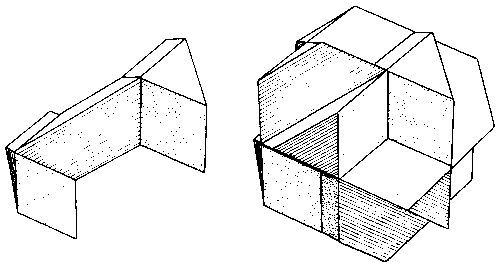
[Home] [Contents] [Figures] [Search] [Help]
[Next Page] [Prev Page] [ Next Chapter] [Prev Chapter]
Another surprise! Having now seen that the second stellation of the rhombic dodecahedron can be constructed by an interlocking assembly of 12 triangular sticks, would you believe that it too can be constructed (more easily, in fact) by an interlocking assembly of six pieces made from square sticks? Start with 18 six-sided center blocks and join them in threes as shown in Fig. 100 to make six identical puzzle pieces, which assemble into the interesting interlocking polyhedral shape shown.
Fig. 100
Now if V-shaped notches are made at both ends of each puzzle piece in the model shown in Fig. 100 the second stellation is produced, as shown in Fig. 101. As practical matter rather than cut notches in the end blocks, it is easier to form them by gluing two suitable blocks together, both of which are easily made from square stock using the saw jig shown in Fig. 90. These are very useful building blocks and will be used frequently in the next two chapters. One of them is a rhombic pyramid, and the other is a five-sided block having the shape of a skewed triangular prism, hereafter referred to as prism block for short.
All of the above models assemble by first forming two halves of three pieces each and then mating the two halves. Unlike those made with triangular sticks, these two halves are mirror images of each other.
| ©1990-2005 by Stewart T. Coffin For questions or comments regarding this site, contact the chief metagrobologist: |
[Next Page] [Prev Page] [ Next Chapter] [Prev Chapter]